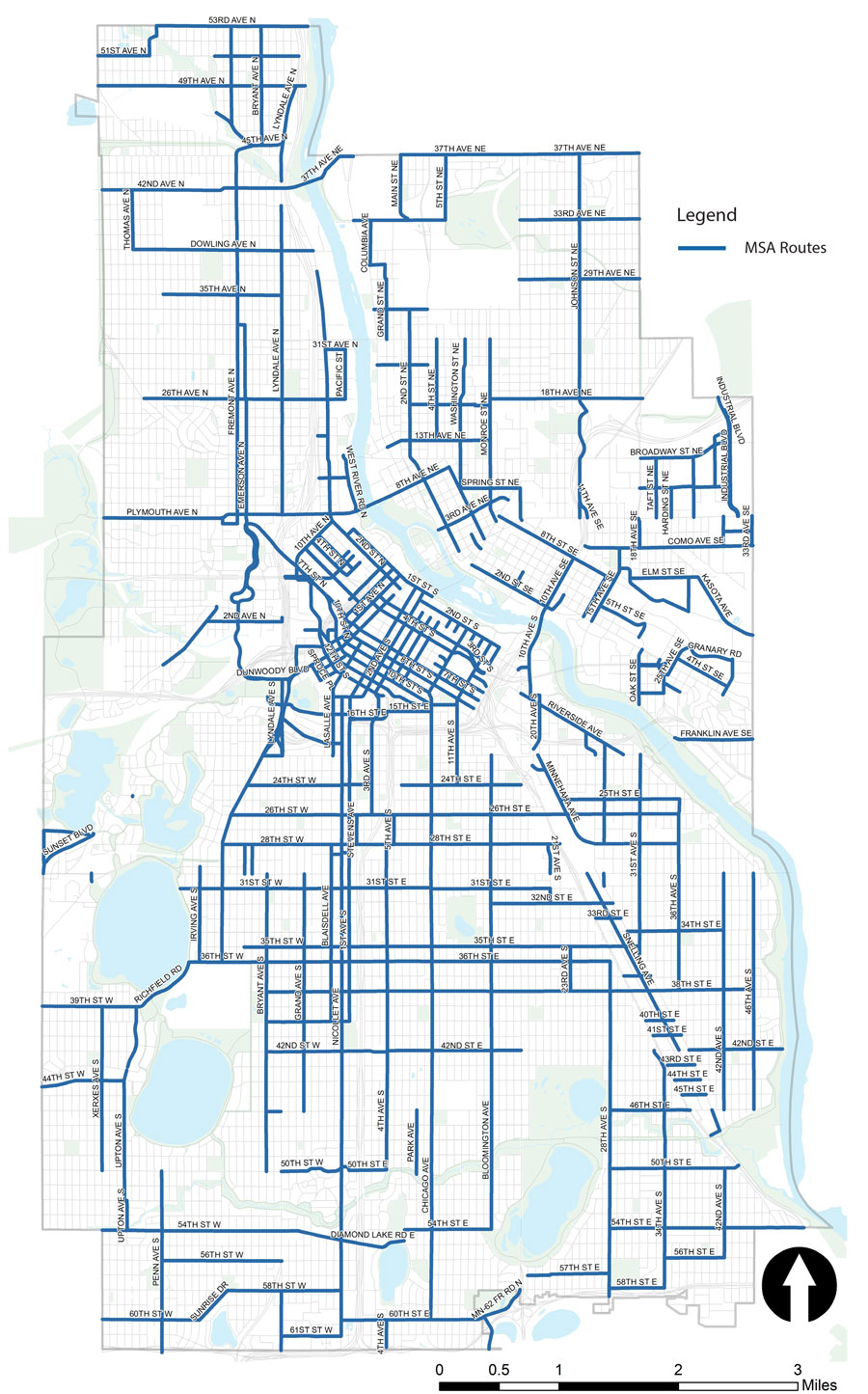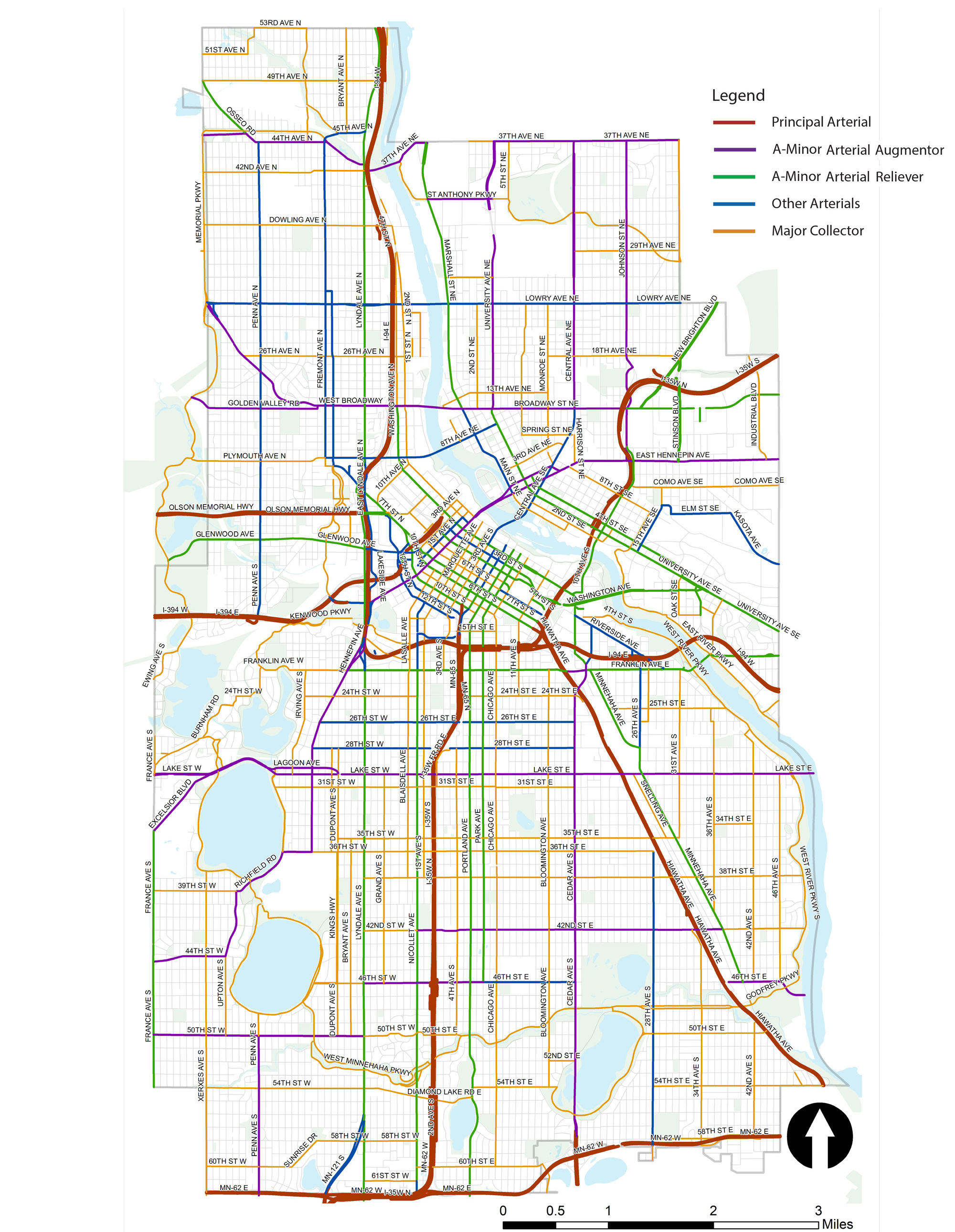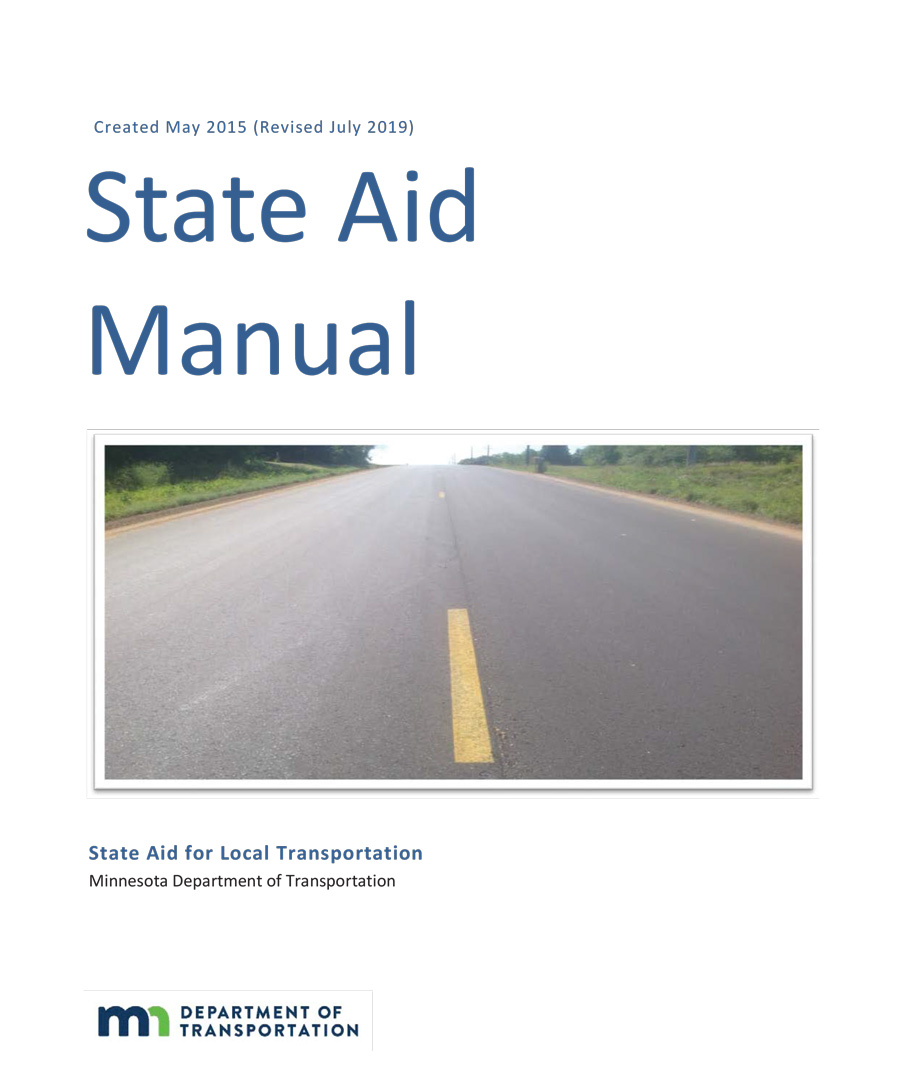Strategy 6 Seek design exceptions and variance to established standards when standards established by other units of government conflict with the City’s Complete Streets Policy.
The actions within this strategy are divided into two categories:
Action we will DOActions we will SUPPORTAction we will do are followed by “DO” and are colored in dark gray, and actions we will support are followed by “SUPPORT” and are colored in light gray.
Learn more about how we get thereRegional functional classification is a national system of classifying streets into different categories, with implications for street design, intersection controls, and speed limits. Classifications have impacts on which streets are eligible to receive regionally allocated federal funds through the Regional Solicitation process. There are 4 classes defined within the Twin Cities metropolitan area, including:
- Principal arterials, which are intended to move vehicle traffic over long distances. The principal arterials in Minneapolis are the Interstate system, Hiawatha Avenue, and Olson Memorial.
- Minor arterials, including A and other minor arterials, which are intended to serve medium-to-short trips and support access to major traffic generators. Examples include Broadway Avenue, Lake Street, Lyndale Avenue, and Johnson Street Northeast.
- Collector streets, including major and minor collectors, which are intended to balance providing direct access to residences and businesses and providing connections between neighborhoods and to arterial streets. Examples include Dowling Avenue North, 18th Avenue Northeast, and 38th Street.
- Local streets, which are intended to primarily provide direct access to residences and businesses and serve only short trips.
Municipal State Aid Routes are designated streets within Minneapolis that are eligible to receive funds for street maintenance and construction based on a formula determined by the State Legislature.
Projects on the State Aid System need to follow the Municipal State Aid Rules, however variances or design exceptions can be sought and granted where desired designs do not conform with current State Aid Standards.
Actions to seek design exceptions and variances when standards established by other units of government conflict with the City’s Complete Streets Policy.
Design 6.1
Work with the Minnesota Department of Transportation to request changes to the Twin Cities Regional Functional Classification System to better align with updated street typologies in the Street Design Guide. Initial changes include:
- Add 3rd Street N/S from 2nd Ave N to Portland Ave as an A-Minor Arterial on the regional functional classification system.
- Add 6th Street N/S from 2nd Ave N to 13th Ave as an A-Minor Arterial on the regional functional classification system.
- Add 11th St N/S and 12th St N/S from I-35W exit to Hawthorne Ave as A-Minor Arterials on the regional functional classification system.
- Add Hawthorn Ave from I-394 entrance/exit to 10th St N as an A-Minor Arterial on the regional functional classification system.
- Add 4th Ave S from Washington Ave S to 7th St S as an A-Minor Arterial on the regional functional classification system.
- Add 5th Ave S from Washington Ave S to 7th St S as an A-Minor Arterial on the regional functional classification system.
- Remove 5th Street S from Park Ave to Chicago Ave as an A-Minor Arterial on the regional functional classification system.
- Remove Minnehaha Ave from 26th Ave to Cedar Ave as an A-Minor Arterial on the regional functional classification system.
- Remove 42nd Street E from Nicollet Ave to Cedar Ave as an A-Minor Arterial on the regional functional classification system and replace with an alternative east-west route with access to I-35W, for example: 35th St and 36th St or 31st Street between Lyndale Ave and Park Ave.
- Add Diamond Lake Rd from Lyndale Ave S to Portland Ave S as an A-Minor Arterial on the regional functional classification system.
- Remove as an A-Minor Arterial on the regional functional classification system Hennepin Ave S from Lake St to 36th St, 36th St W from Hennepin to Richfield Rd, Richfield Rd/39th St from 36th St to Sheridan Ave S, Sheridan Ave S/Upton Ave S from 39th St to 44th St, and 44th St W from Upton Ave to France Ave.
- Remove St. Anthony Pwky NE from Marshall St NE to University Ave NE as an A-Minor Arterial on the regional functional classification system.
- Adjust other streets as appropriate.
Supported goals:
Active Partnerships
Related actions:
Difficulty:
Low
Timeframe:
2020-2023 (Years 0-3)
Design 6.2
Evaluate potential changes the City may request to the Municipal State Aid Routes to better align with the updated street typologies.
Supported goals:
Active Partnerships
Related actions:
Difficulty:
Low
Timeframe:
2020-2023 (Years 0-3)
Design 6.3
Evaluate potential changes to the Municipal State Aid Rules the City may advocate for to provide flexibility needed for the City to use the Street Design Guide with few or no variances.
Supported goals:
Active Partnerships
Related actions:
Difficulty:
Low
Timeframe:
2024-2027 (Years 4-7)
Design 6.4
Evaluate the need for variances, design exceptions and pilots to support the use of the Street Design Guide during street reconstruction projects.
Supported goals:
Mobility Active Partnerships
Related actions:
Difficulty:
Low
Timeframe:
2020-2023 (Years 0-3)
Status:
On-going
See also actions:
- Freight 2.3
Design vehicles on State Aid system


